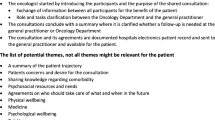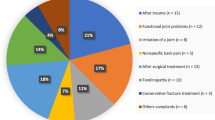Abstract
Goals of work
This study aimed to use an integrated system (Medical Care Continuity (MCC) system) consisting of computer, video telephone, and a high-definition camera to monitor at home chemotherapy side effects in cancer outpatients.
Patients and methods
The system allowed 24 h/day video consultation with an intermediate medical call center with possible connection to a specialized hospital if necessary. All patients were provided with internationally validated and project-oriented questionnaires exploring patients’ health status and opinions on usefulness and complexity of study devices. The content of each call was recorded on a computer database. An approximate estimate of avoided hospital admissions was calculated.
Main results
Median duration of experimentation and frequency of patient/doctor contacts were 2.1 months and 4.2 contact per week, respectively. Overall, a 98% positive opinions on the experimental system was reported at the end of the study by all participants, with a 21% conversion rate with respect to the opinions gathered at study entry. Changes in patient management after a medical call were made in 32% of cases. It was calculated that approximately 2.2 per month unnecessary hospital admissions were avoided.
Conclusions
The MCC system was well managed by both patients and caregivers. These results show that it has the potential to improve medical assistance by virtue of a constant access to medical advice and reduce unnecessary hospital admissions.






Similar content being viewed by others
References
Berard RM (2001) Depression and anxiety in oncology the psychiatrist’s perspective. J Clin Psychiatry 62:58–61
Bjelland I, Dahl AA, Haug TT, Neckelmann D (2002) The validity of the hospital anxiety and depression scale. An updated literature review. J Psychosom Res 52:69–77. doi:10.1016/S0022-3999(01)00296-3
Camara JG, Zabala RR, Henson RD, Senft SH (2000) Teleophthalmology: the use of real-time telementoring to remove an orbital tumor. Ophthalmology 107:1468–1471. doi:10.1016/S0161-6420(00)00211-6
Cassidy J, Twelves C, Van Cutsem E, Hoff P, Bajetta E, Boyer M et al (2002) Capecitabine Colorectal Cancer Study Group: a favorable safety profile compared with intravenous 5-fluorouracil/leucovorin. Ann Oncol 13:566–575. doi:10.1093/annonc/mdf089
Chumbler NR, Kobb R, Harris L, Richardson LC, Darkins A, Sberna M et al (2007) Healthcare utilization among veterans undergoing chemotherapy: the impact of a cancer care coordination/home-telehealth program. J Ambul Care Manage 30:308–317
Dowd S, Davidhizar R (1999) Opening up to the Katz index. Elder Care 11:9–12
Hebert MA, Paquin MJ, Whitten L, Cai P (2007) Analysis of the suitability of “video-visits” for palliative home care: implications for practice. J Telemed Telecare 13:74–78. doi:10.1258/135763307780096203
Herrmann C (1997) International experiences with the hospital anxiety and depression scale—a review of validation data and clinical results. J Psychosom Res 42:17–41. doi:10.1016/S0022-3999(96)00216-4
Karnofsky DA, Burchenal JH (1949) The clinical evaluation of chemotherapeutic agents in cancer. In: Macleod CM (ed) Evaluation of chemotherapeutic agents. Columbia University Press, New York, pp 199–205
Kunkler IH, Prescott RJ, Lee RJ, Brebner JA, Cairns JA, Fielding RG, Bowman A, Neades G, Walls AD, Chetty U, Dixon JM, Smith ME, Gardner TW, Macnab M, Swann S, Maclean (2007) TELEMAM: a cluster randomised trial to assess the use of telemedicine in multi-disciplinary breast cancer decision making. Eur J Cancer 43:2506–2514. doi:10.1016/j.ejca.2007.08.026
Larcher B, Arisi E, Berloffa F, Demichelis F, Eccher C, Galligioni E et al (2003) Analysis of user-satisfaction with the use of a teleconsultation system in oncology. Med Inform Internet Med 28:73–84. doi:10.1080/14639230310000600470
Lassere Y, Hoff P (2004) Management of hand–foot syndrome in patients treated with capecitabine (Xeloda). Eur J Oncol Nurs 8:S31–S40. doi:10.1016/j.ejon.2004.06.007
Lloyd-Williams M, Spiller J, Ward J (2003) Which depression screening tools should be used in palliative care. Palliat Med 17:40–43. doi:10.1191/0269216303pm664oa
Mair F, Whitten P, May C, Doolittle GC (2000) Patients’ perceptions of a telemedicine specialty clinic. J Telemed Telecare 6:36–40. doi:10.1258/1357633001933925
Purkable TL, Bauer JJ (1999) A telementored trans-rectal ultrasound guided prostate biopsy. Stud Health Technol Inform 62:275–277
Smith TJ, Khatcheressian J, Lyman GH, Ozer H, Armitage JO, Balducci L et al (2006) 2006 update of recommendations for the use of white blood cell growth factors: an evidence-based clinical practice guideline. J Clin Oncol 24:3187–3205. doi:10.1200/JCO.2006.06.4451
Snaith RP (2003) The hospital anxiety and depression scale. Health Qual Life Outcomes 1:29. doi:10.1186/1477-7525-1-29
Ware JE Jr, Gandek B (1998) Overview of the SF-36 health survey and the international quality of life assessment (IQOLA) project. J Clin Epidemiol 51:903–912. doi:10.1016/S0895-4356(98)00081-X
Ware JE Jr, Sherbourne CD (1992) The MOS 36-item short-form health survey (SF-36). I. Conceptual framework and item selection. Med Care 30:473–483. doi:10.1097/00005650-199206000-00002
Zigmond AS, Snaith RP (1983) The hospital anxiety and depression scale. Acta Psychiatr Scand 67:361–370. doi:10.1111/j.1600-0447.1983.tb09716.x
Author information
Authors and Affiliations
Corresponding author
Rights and permissions
About this article
Cite this article
Formica, V., Fossile, E., Pellegrino, R. et al. The Medical Care Continuity (MCC) project. A pilot study of video-assisted home care within the eTEN European Community program. The Italian experience. Support Care Cancer 17, 471–478 (2009). https://doi.org/10.1007/s00520-008-0559-1
Received:
Accepted:
Published:
Issue Date:
DOI: https://doi.org/10.1007/s00520-008-0559-1




